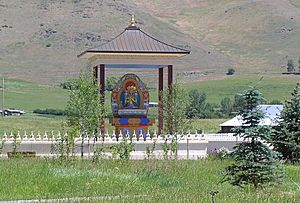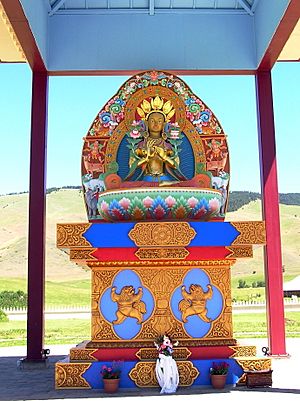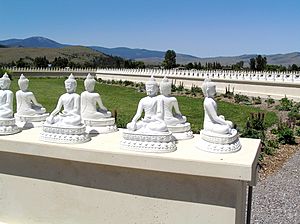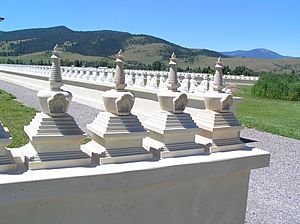Garden of One Thousand Buddhas facts for kids
The Garden of One Thousand Buddhas is a special spiritual place in Arlee, Montana. It's located on the Flathead Indian Reservation in Lake County, Montana. This garden is still being built, but it's already a big area. The main part is about 750 square feet, and the whole garden covers 10 acres. It's meant to be a place where people can go on a spiritual journey. The builders hope it will become an important place for people of many different beliefs. It's free to visit and will have more than a thousand statues when finished.
Contents
History of the Garden
The Garden of One Thousand Buddhas was started by a man named Gochen Tulku Sang-ngag Rinpoche. He is a Tibetan Buddhist teacher from the Nyingma school of Buddhism.
Sang-ngag Rinpoche chose this spot because it matched a dream he had when he was young. His non-profit group, Ewam, received the land as a gift. Construction on the garden began in the year 2000.
Today, many volunteers help take care of the garden. They also make the 1,000 statues out of concrete. The 1,000 stupas (special dome-shaped structures) needed for the garden are already finished. The biggest statue is of a goddess named Tara. It stands in the middle of the garden and is complete.
In 2010, about 450 of the 1,000 Buddha statues were done. They are being stored until all of them are ready to be placed. More statues have likely been made since then. The garden hopes to have a visit from the 14th Dalai Lama when it is fully completed.
Garden Design and Meaning
The Wheel of Dharma
The garden is located in the Jocko Valley. The main part of the monument is a walking path shaped like a dharmacakra. This word means "Wheel of Dharma" and is a very important symbol in Buddhism.
The Wheel of Dharma stands for the teachings of the Buddha. It especially represents the Noble Eightfold Path, which is a guide for living. It also shows the cycle of life, death, and rebirth. The wheel is also a type of mandala, which can represent all of existence.
The path is 500 feet wide. It has an outer circle and eight straight lines that go out from the central statue of Tara.
Yum Chenmo, the Great Mother
The main statue in the center is of a goddess called Prajnaparamita. She is also known as Yum Chenmo, or "The Great Mother." She represents a very wise and enlightened woman. She teaches that the world we see with our senses is not always what it seems.
Her statue is 24 feet tall. It has a beautiful base with traditional Buddhist designs.
The 1,000 Buddhas
Each straight path in the garden will have 125 statues of male Buddhas. These statues are two feet tall. They represent the 1,000 special beings, or avatars, mentioned in Buddhist texts. These avatars are believed to help the world in different time periods. Gautama Buddha was the fourth of these avatars.
Garden Plants and Features
The garden area will have many beautiful flowering plants. There will be a lot of lavender and 1,000 planted trees. Other features include a pond and four prayer wheels.
Purpose and How the Garden is Used
Sang-ngag Rinpoche hopes the garden will spread Buddhist ideas like joy, wisdom, and kindness. He wants to share these ideas in a place where Eastern philosophy is not very well known. The goal is to help everyone get closer to enlightenment. This is the main goal for Boddhisatvas, who are enlightened beings who choose to help others.
The center of the garden is used for special gatherings. People use it for group or individual prayer, speeches, and music. The local Salish-Kootenai people also share spiritual practices there.
In 2011, tribal leaders said they were thankful for the garden's open and welcoming nature. This was different from other cultures that had moved onto tribal land. The Buddhists and the Confederated Salish Kootenai Tribes share some similar beliefs. They also share a history of facing challenges in their home lands. Sang-ngag Rinpoche himself was held in prison for ten years during the Chinese Invasion of Tibet.
The statue of Tara can be used for a practice called darshan. This is similar to Buddhist meditations where you focus on a deity. In darshan, a worshiper focuses deeply on the meaning of a temple's main statue. Some Buddhists and Hindus believe that a very dedicated person might feel a blessing or even a special connection with the divine through a statue.
Such art is called murti. This means the divine is represented in an object. People don't worship the object itself. Instead, the murti helps connect them to a higher power. This power is believed to be everywhere.
The outer circle of the garden is used for circumambulation. This means walking clockwise around a sacred place. While walking, people meditate on the idea that life and existence are like a cycle.







